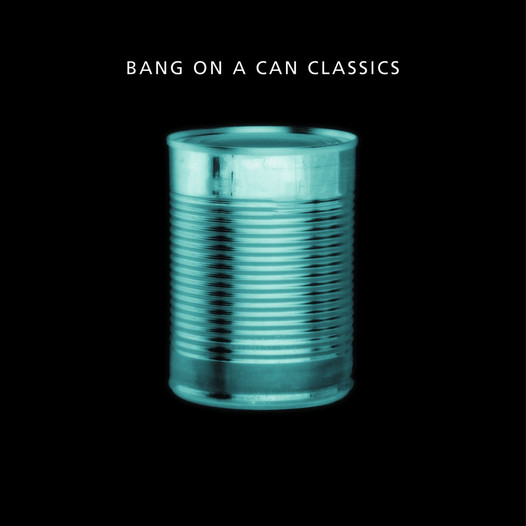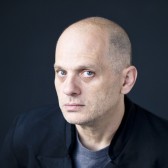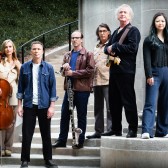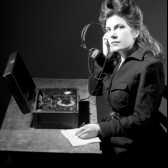The Bang on a Can All-Stars emerged from the scruffy environs of downtown New York playing a new kind of music, with a new kind of energy, for a new kind of audience. This reissue has the music that made them famous - their breakthrough CDs for Sony Classical newly packaged and remastered onto one 74-minute disc. Enjoy.
Music by Nick Didkovsky, Michael Gordon, Annie Gosfield, David Lang, Julia Wolfe, Lois V. Vierk, and Evan Ziporyn.
cheating, lying, stealing
A couple of years ago, I started thinking about how so often when classical composers write a piece of music, they are trying to tell you something that they are proud of and like about themselves - here's this big gushing melody, see how emotional I am. Or, here's this abstract hard-to-figure-out piece, see how complicated I am, see my really big brain. I am more noble, more sensitive, I am so happy. The composer really believes he or she is exemplary in this or that area. It's interesting, but it's not very humble. So I thought, "What would it be like if composers based pieces on what they thought was wrong with them?" Like, here's a piece that shows you how miserable I am. Or, here's a piece that shows you what a liar I am, what a cheater I am. I wanted to make a piece that was about something disreputable. It's a hard line to cross. You have to work against all your training. You are not taught to find the dirty seams in music. You are not taught to be low-down, clumsy, sly and underhanded. In cheating, lying, stealing, although phrased in a comic way, I am trying to look at something dark. There is a swagger, but it is not trustworthy. In fact, the instruction on the score for how to play it says: Ominous funk. – David Lang
Lick
I see music as something other than presentation. Each piece is its own world that I've found a way into. It starts from an emotional place - not sentimental or an expression of an emotion - but connected to the spirit. I begin with an image - a fragment of a tune, a visual or sonic image - a joyous, active, rhythmic thing that unravels like a little knot. To really make a piece and not just piece things together, you have to be less attached to every moment and stand back and let the music go how it wants to go. It's a funny combination of intuition and construction. Lately I have been veering more towards the power of sound. There's an insistence, a feeling of pushing things to the edge, and there's a certain kind of groove, a dance quality. The body energy of pop music has come into my music and it's definitely in Lick. Motown, funk, rock - this is the music I grew up on, listening, dancing to it. It has a certain kind of freedom to it. Lick has a lot of meanings and the piece has to do with all the meanings you can think of. It's saucy and it has an edge. It's impatient; although it stays with things for a long time, it hammers at them. I took a fragment, a lick, and magnified it. And the beat is split up by all the players, so it becomes fragmented, a fragmented energy. The piece is about attacks, but it has a more sensual side. I really thought about the Bang On a Can All-Stars when I wrote it because I wanted to see them lock in with this intense energy. It's definitely over the top. – Julia Wolfe
The Manufacture of Tangled Ivory
I generally start with keyboard first. Then I often do improvisational work with percussionist Christine Bard and guitarist Roger Kleier - parts of this piece were developed in our trio. As to the title, The Manufacture of Tangled Ivory, "ivory" refers to the keys of the piano. And "tangled" was a way of describing the detuned and altered the piano sounds that I've been exploring for a long time. The notes are actually displaced on the keyboard. In this piece, I tried to increase the density of layers of these sounds and see what kind of contrast I could bring out. In the keyboard solo that begins the piece, some parts are rubato and others sound like a player piano, fast and mechanical. In fact, the piece incorporates metallic, factory sounds, like some of the music of the Russian avant-garde composers from the early part of the century. That's where "manufacture" comes from. I was also thinking about my grandmother, who moved from Poland to the Lower East Side in New York, working in sweatshops and factories at about the same time these composers were working in Russia. I've been in New York for four years, and live in the same neighborhood, but the differences between her experience and mine are vast. – Annie Gosfield
Tsmindao Ghmerto
In college, my teachers tried to change the way I played because I didn't have a classical sound, but I didn't like the way classical players sounded - I was too interested in jazz and pop and music of other cultures. I felt there was something flawed about the idea that music meant Western music - it seemed like we were being sold a bill of goods. I became more interested in the music of Eastern Europe and Asia, Balinese music. For a long time I made a separation between interest in those musics and my own work, and then I realized I had to take my interest seriously. Tsmindao Ghmerto literally means "Holy God" or "Sanctus." It's based on a Georgian religious vocal piece for men's chorus. I heard this piece sung by a choir on a record, and I liked it. I didn't know how it worked, I didn't even know it was three-part harmony.
One night I had insomnia and I was looking for something to do, and I thought, "Well, I'll transcribe the piece." Then I started to fool around with it in the same way on the bass clarinet. The idea was to make explicit the way I heard the original, which is a very subjective thing. You construct a hearing just like you construct a reading of the book. So the whole idea of this arrangement was not to deliberately redo the piece but to find a way to make my hearing of it evident. I had to figure out how to get three notes at once in a controlled way, so that you would hear the same harmony as it was sung by the choir. What I would do is hum one note and sort of tremolo between the other two really fast. But as I was working on it, in the climactic moment of the piece, it turned out that in the key I had chosen one of the three notes was an exact harmonic of another. So I could play a multiphonic on that fundamental note and get it and its harmonic while I sang the third note. I was getting three notes at once. It was one of those divine coincidences. It doesn't necessarily sound all that different to the listener from anything else that is going on. But for me it's this point that I'm aiming for. Multiphonics and extended techniques are so dependent on things that you can't control - the humidity of the room, the acoustics, the shape of your reed at the moment. It's all about finding the stuff in the cracks of the instrument. The whole thing was very unplanned and unartistic in the self-conscious sense of that word. – Evan Ziporyn
Red Shift
Years ago, as an undergraduate at UCLA, along with extensive studies in Western music, I studied Gagaku with Suenobu Togi. Gagaku is Japanese court music, and Mr. Togi is originally from the Emperor's Court Orchestra in Tokyo; he traces his ancestry of performing Gagaku back to the year 800 A.D. The sound of Gagaku - which means "elegant music" - is massive and strong but at the same time graceful and elegant. The word literally means "elegant music." The graceful crescendos and decrescendos and the slow, unfolding melody spoke to me immediately.
Before they ever pick up instruments, musicians in this tradition learn to sing the melodies, memorizing by rote. Then they are given lessons in dance. They breathe together. They know the art form from the inside out, how all the parts fit together. As a Westerner, I got the crash course, but I learned to love the slow, unhurried melodies and how each slide in pitch, instead of being merely decoration, functions to move the phrase forward. The slides to me are just so beautiful. They are a very natural sound. If you hear the sound of the wind or water, if you listen to birds, to animals howling, even to the human voice, there are all sorts of gradations and slides in pitch.
Red Shift refers to the way astronomers and physicists measure movement and distances of far away celestial bodies. When I wrote this work, I had the feeling of something of great mass and motion, far away, like a comet, first seeming to move slowly, then gradually accelerating towards us, faster and faster, until finally at great speed it swoops by us and through us, back out into space. – Lois V. Vierk
Amalia's Secret
I wrote this piece during a cold winter in New York City a few years ago, when isolation, solitude and loneliness were big themes brought on by particularly bitter weather. I was reading Kafka's The Castle then, which is also about solitude and being a victim of a system that is bigger than you are. I was completely captivated by one particular chapter, Amalia's Secret. It seemed to resonate with the melancholy and difficulty of life at that time. So I zoned in on it as a metaphor to give a rough narrative thread to this piece I had written. To get the titles, I mixed Kafka's text with some of my own prose and fed them into a program I wrote. The program, acting like a food blender, mashed them up and spat out sentence fragments and paragraphs of words that made sense statistically if not semantically. I then selected short phrases that captured my attention. That's how I got the titles for each section.
I like to be surprised, to be flooded with possibilities and to use computers in a loose way, scrambling things, creating surrealistic, dada-istic experiments. Much of the raw material that lies at the heart of "Amalia" was generated by my music composition software, which generates hundreds of ideas a minute. When I first used the software, everything that came out sounded good, just because it was new. After a while I began to hear similarities between ideas, so the threshold of what's interesting gets raised. The ear starts to pick out things that are truly unique. You rely on primitive intuition. I'll hear something, save it, load it into a commercial arranging program, add phrases, cut and paste. By contrast, some sections derived their raw material from my live improvisation, rather than from my software.
The solo guitar movement (Two Heads, Sitting Together) is a good example. I improvised it live in my software and then edited it. There are a lot of blurry boundaries in this way of working. I'm interested in that ambiguity. I don't write many dynamic markings, phrase indications, etc, in my music. The only thing I really specify is tempo. I'm happy to be able to give the All-stars that kind of freedom. It's a privilege to listen to something that I created and gave to them and see it grow up and be reflected back. My favorite of the gestures is Amalia's Secret. It really is the heart of the piece - a little jewel, fragile and fleeting, like a breath, brave but sad. – Nick Didkovsky
Industry
After the Russian Revolution, there was a period where Russian composers tried to make pieces that sounded like factory sounds. When I wrote Industry in 1993, I was thinking about the Industrial Revolution, technology, how instruments are tools and how industry has crept up on us and is all of a sudden overwhelming. I had this vision of a 100-foot cello made out of steel suspended from the sky, a cello the size of a football field, and, in the piece, the cello becomes a hugely distorted sound. I wrote it specifically for Maya, and it was an incredible process. I would fax her the music and she'd play it to me over the phone. We did this maybe ten times, trying things out. She was constantly teaching me about the cello, and I was making her play things that were really awkward and dark. The fact that the piece is difficult to play is an understatement. – Michael Gordon







